Air
Layering

Spring has long sprung,
and we are reminded that it is the time for propagation.
In ancient China, gardeners
used a method of propagating plants called layering. That's where
you get the branch, pull it down while still attached, and secure
it somehow to the soil.
We want to do a cutting
from this Ficus benjamina, but the branches are too high
off the ground. So what we're going to show you is air layering.
It's a simple process and involves making a wound in the plant.
First, trim away some
of the growth so you can see what you're doing. The areas where
the branches and leaves come through — called nodes —
are where the roots will come from when we attach the sphagnum moss.
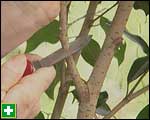 Clear
away an area of plant. You need a reasonable amount of bare branch.
Don't worry that it bleeds a little. That's what rubber plants do.
It's not going to hurt the plant. Clear
away an area of plant. You need a reasonable amount of bare branch.
Don't worry that it bleeds a little. That's what rubber plants do.
It's not going to hurt the plant.
Then make your cut. This
can be a little tricky, so make sure you use a sharp knife.
Cut about 5 mm in. You're
actually after a tongue of wood immediately below the node —
just slice upwards to it. The roots will emerge from the gap where
it is cut.
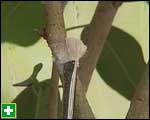 You
can help the process along by using rooting hormone for semi-hardwood
cuttings. Brush it on quite generously. You
can help the process along by using rooting hormone for semi-hardwood
cuttings. Brush it on quite generously.
Meanwhile, soak some
sphagnum moss in water for about 30 minutes.
It needs to absorb plenty
of water because once you've sealed it in its plastic bag, it won't
get any water for about three months.
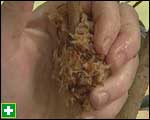 Pack
the sphagnum moss around the cut branch so that it's keeping the
two bits of the branch separate. That's because the roots need room
to come out from the cut. Pack
the sphagnum moss around the cut branch so that it's keeping the
two bits of the branch separate. That's because the roots need room
to come out from the cut.
Take a piece of plastic
and wrap that around the base of the cut branch and sphagnum. The
whole point of this is so that water cannot get out or in.
It has to be properly
sealed, so make sure you have a reasonable piece of tape. Wrap the
tape around the plastic to secure it tightly.
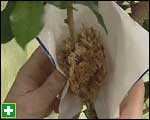 If
necessary, pack in a wee bit more sphagnum moss through the opening
at the top. If
necessary, pack in a wee bit more sphagnum moss through the opening
at the top.
With the plastic, although
the white is unattractive, at least it has the properties the plant
needs. If it were black and the plant was in sunlight, it would
overheat inside. Although the rooting hormone has fungicide, black
plastic isn't recommended.
Nor is clear plastic
because algae may build up, and you then find yourself opening the
bag in great excitement two months later to find it's rotted.
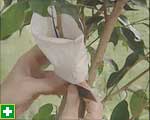 Secure
the plastic at the top. Secure
the plastic at the top.
Check the way the plant
is progressing after about eight weeks or so.
You need to be patient
because it takes at least two to three months to root. Some plants
like rhododendron and camellia might take the whole growing season.
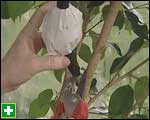 Once
the plant has rooted, take a pair of sharp secateurs and snip it
off. Peel away the plastic and you will have the roots there —
and a new plant. Once
the plant has rooted, take a pair of sharp secateurs and snip it
off. Peel away the plastic and you will have the roots there —
and a new plant.
There's all sorts of
plants you can do that with, including the New Zealand or Australian
tea-tree. Try experimenting with different plants.
Reproduced
with permission from NZOOM Home and Garden content,
from the previous
website of 
The views expressed here are not necessarily those of the RNZIH
 |
|
HOME
AND GARDEN |
|
|
More
Garden Articles
|